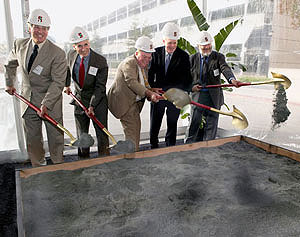October 28, 2008 - By Ruthann Richter

Robert Klein, Philip Pizzo, Lorry I. Lokey, John Hennessy and Irving Weissman at the Oct. 27 groundbreaking.
The School of Medicine took one step closer to opening the nation's largest stem cell research facility with groundbreaking ceremonies Oct. 27 for the Lorry I. Lokey Stem Cell Research Building. The event followed a symposium in which researchers described some of the potential of stem cells in treating diseases as diverse as leukemia and Parkinson's disease.
The 200,000-square-foot building will bring together some 600 scientists now working in scattered locations in a unified effort to capitalize on the power of stem cells, which some predict will revolutionize the practice of medicine. The $200 million building, designed by the firm Zimmer Gunsul Frasca Architects LLP, is scheduled to open in the summer of 2010.
"This is an extraordinary day," Philip Pizzo, MD, dean of the medical school, told a crowd of some 200 attendees. He said the building represents a new future in medical research. "That future will lead us to an explanation of human disease and better ways of treating it."
Scientists in the building will be involved in the full spectrum of stem cell programs, including research in embryonic and adult stem cells, cancer stem cells and the development of disease-specific stem cell lines. They will represent a wide range of disciplines, including neurology, cancer, transplantation, immunology, cardiology, developmental biology and bioengineering.
"What is important is that it will give people the opportunity to apply stem cell thinking to different problems, including regeneration, aging and cancer," said Irving Weissman, MD, director of the Stanford Stem Cell Biology and Regenerative Medicine Institute, which will be housed in the new building.
The four-story facility along Campus Drive will be designed with a look reflective of Stanford's main quad, with its limestone exterior and red-roof elements, said project manager Chris Shay. The building has an open design to encourage collaboration, with a large atrium lobby, which will also serve as a pedestrian thoroughfare to other parts of the medical school campus. Two major wings, which will lead off of the lobby, will offer private areas for focused research. Within these "neighborhoods," there will be small, park-like areas to encourage scientists to intermingle.
Dispersed around the building will be 60 "hotel" benches reserved for researchers both inside and outside of Stanford who may spend a month to a year on joint projects. Some of these projects are already under way in which basic researchers have paired with clinicians to work on stem cell-based approaches to such problems as breast cancer and leukemia.
The building will also afford scientists the opportunity to work with their colleagues in ways that haven't been possible before. For instance, it will house a microfluidics laboratory, where scientists will be able to use these new tools to isolate and study rare cells.
"Our ultimate goal is to be able for the first time to figure out the biochemistry of single cells so we can tell one stem cell apart from another," Weissman said. "We could look at the difference between a neuron that's involved in depression from one involved in schizophrenia. That way, we can really move this field forward."
The building will also expand the work of Stanford's Cancer Center, which will have a major presence there. "It will provide a new base for the center, where we can interact with those across the university working in stem cell biology," said Beverly Mitchell, MD, the center's director. "It will provide space for our new recruits to enhance our programs. It will be a huge boost to cancer research."
The building has already helped to attract top talent to Stanford in the stem cell field. "We have not only been able to recruit faculty, we have been able to recruit the best faculty," President John Hennessy said at the ceremony.
The California Institute for Regenerative Medicine, the state stem cell agency, has provided a grant of $43.6 million to help pay for construction, and its chair, Robert Klein, joined in the ground breaking. In addition, at least $130 million will come from philanthropic contributions, including a $75 million gift from Lorry I. Lokey, the Business Wire founder for whom the building is named. Other gifts include $10 million from Mill Valley, Calif., investment banker John Scully and his wife Regina, and a gift from Thomas Steyer, a university trustee, and his wife Kat Taylor. The balance will come from university resources.
"Chances are even I will benefit from what happens here in the next five, 10 years," Lokey, 81, told the scientists at the event. "I wish you the best, because my life might depend on you."
About Stanford Medicine
Stanford Medicine is an integrated academic health system comprising the Stanford School of Medicine and adult and pediatric health care delivery systems. Together, they harness the full potential of biomedicine through collaborative research, education and clinical care for patients. For more information, please visit med.stanford.edu.